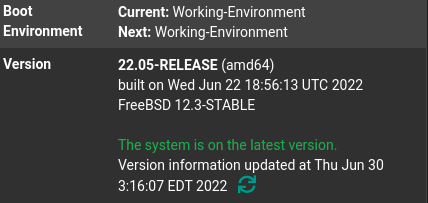after 22.05 update - still showing as available
-
after a successful 22.05 update still showing available (rebooted twice)


-
There are a few other threads for this already, but I'll copy this response here again:
If it still shows that, then part of your upgrade did not complete properly.
We have seen similar things happen for as few different reasons but no one thing has stood out as being the most common yet and though we've had a handful of reports it still only seems to affect a small number of users total.
- Some users have manually defined third party package repositories and some packages in those repositories are outdated or conflict (ntop seems to be a common problem here) -- removing the alternate repositories and re-running the upgrade from the CLI with
pfSense-upgradeshould fix this. - A package, such as squidGuard, gets hung up during the upgrade and prevents it from fully completing. -- Stopping the package service (e.g. squidGuard) manually from Status > Services should allow the remainder of the upgrade to complete, alternately, from the CLI run
killall -9 pkgand see if it continues. Otherwise, reboot and re-run the upgrade from the CLI withpfSense-upgrade. - Systems with multiple disks that had installations on both (e.g. device shipped with MMC but later added an SSD) may be booting from the MMC but upgrading the OS on the SSD. There are a couple different potential methods for working around this but they can be more potentially dangerous, but tl;dr is you need to erase the MMC so the SSD install can work completely.
- Something else interrupted the upgrade, such as a user pulling the plug while it was still working because they felt it was taking longer than expected. In this case, re-running the upgrade may help, but a reinstall is better.
- Some users have manually defined third party package repositories and some packages in those repositories are outdated or conflict (ntop seems to be a common problem here) -- removing the alternate repositories and re-running the upgrade from the CLI with
-
@morreale run in CLI pfSense-upgrade -d. Worked for me.

-
@jimp thanks.
-
 B bmeeks referenced this topic on
B bmeeks referenced this topic on
-
 B bmeeks referenced this topic on
B bmeeks referenced this topic on
-
 B bmeeks referenced this topic on
B bmeeks referenced this topic on
-
 B bmeeks referenced this topic on
B bmeeks referenced this topic on
-
S SteveITS referenced this topic on
Copyright 2025 Rubicon Communications LLC (Netgate). All rights reserved.